I recently spoke at Affiliate Summit West 2020, my first time speaking at an industry conference, on the topic of Driving Revenue Leveraging Publisher Payouts. This presentation was a career goal that I thoroughly enjoyed achieving. In case you missed ASW this year or were unable to catch my presentation never fear. I’ve summarized the take-aways below.
The goal of my presentation, and of this post, is for you to walk away with 5 practical ways to drive more revenue by leveraging the tools you should already have available to you. Ideally, without too much effort or heavy lifting required by your advertiser.
The goal of a tiered commission system is to drive incremental revenue.
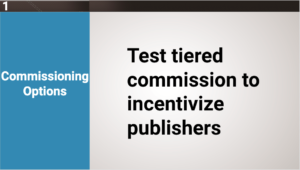
#1 Test Tiered Commissions to Incentivize Publishers
I have a proven track record of success over my 12+ years in the affiliate space leveraging tiered commission payouts to drive additional revenue. Typically, I have used tiered commissions for:
Activation campaigns
Identify non-productive publishers, driving clicks, but not sales, over a specific time period, i.e. Year over Year in Q1, and offer a tiered commission plan based on performance KPI’s you are trying to increase. For example, your campaign could target publishers driving clicks, but 0 sales, etc.
Recruitment campaigns
Offer publishers who join an affiliate program a tiered commission over their first 90-days to help motivate them to put in the effort into promoting a new affiliate program. This may look like 2% increase for generating 5 sales in the first 30-days, 4% commission for generating 5 more sales, 10 totals, in 60-days and 6% commission for generating 5 more sales, 15 totals, in the first 90-days.
Optimization campaign
Offer a personalized tiered commission for mid to top performing publishers within an affiliate program to try and drive even more sales.
A few things to keep in mind with a tiered commission plan:
- Make sure the plan is easy to understand and track.
- Follow through with commission increases based on the tiers for publishers who qualify.
- Notify publishers who qualified for increased commission at the end of each month to be sure they know you have their best interest in mind.
Tiered commission campaigns can be an effective way to drive incremental revenue, without much risk, since there is not any cost for publishers who don’t perform.
Best Publishers to test tiered commission plans with:
- Coupon and vertical publishers respond best to these types of tiered commission plans. They are able to project earnings based on traffic and current conversion rate to estimate their earnings to determine any additional placements they could provide for a tiered commission plan.
- Content publishers are also a good fit for these types of campaigns. For these publishers, you may consider a longer campaign cookie since their site visitors are typically top of funnel and may not be ready to purchase within 3 to 7 days.
- Loyalty and cash back publishers are not motivated by a tiered commission campaign since they are not able to determine the commission increase and therefore, they don’t know how much additional commission will be passed back to their members.
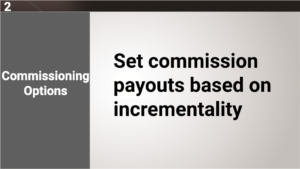
#2 Set Commission Payouts Based on Incrementality
The key to this strategy is making sure you and your advertiser have a clear understanding of what they consider to be an incremental sale. Once you and your client have agreed upon a definition of incrementality, the next thing is making sure it is measured accurately.
Two rules I learned regarding commissioning publishers on incrementality are:
- Don’t payout commission on something you can’t measure and report on
- Don’t make your payout plans so complicated that your affiliate partners can’t do anything on their end to actually target those specific customers
Lastly, make sure the appropriate commission rate for each publisher in your affiliate program is aligned with the traffic and revenue they drive.
Case study
Our men’s clothing and shoe retailer simply needed a more advanced technology partner that allowed them more creative and sustainable commission rules. The team at JEBCommerce, after a full network review, re-launched the program on ShareASale and utilized their Conversion Lines and LeapFrog technology to ensure that affiliates entering the path to purchase after the customer placed their items in the shopping cart did not earn a commission. The assumption that was made was that those sales were not incremental and did not earn the commission.
As sales continued to grow that year, the client realized an incredible $95,000 in savings from commissions they did not have to pay that fell outside of their new commissioning rules. That re-discovered budget was then deployed into focused paid placements with affiliates that led to a 64% increase in YoY revenue.
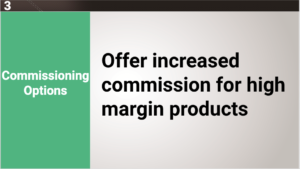
#3 Offer Increased Commission for High Margin Products
Work with your client to understand which products have the highest margins and offer higher commission for these products. Publishers often follow the money, so this may be an opportunity for them to earn more by focusing their efforts on specific SKUs.
This may require GA access or a conversation with the Business & Intelligence team – your day-to-day client may not have this data at his or her finger tips, but if they understand the WHY behind it – to drive higher AOV and bottom line revenue, I am pretty sure they will be interested. (Pro tip – always work with your advertisers to know how they measure data internally and ask for access to their Google Analytics.)
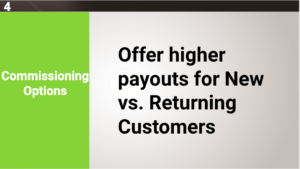
#4 Offer Higher Payouts for New vs. Returning Customers
Another way to drive revenue is by leveraging a commission strategy that pays out more on New vs. Returning (or Existing) customers. This key to this strategy is similar to step #2 regarding incrementality is having a clear understanding of how your client defines a NEW customer vs. existing customer. Like incrementality, there are several different ways to define what qualifies as a new customer.
Here are some examples we have seen from our clients in the past in terms of defining new customers:
- Is a new customer someone who has never shopped on your site or someone who hasn’t made a purchase in a certain amount of time? If so, what is that timeframe? Three months? Six months?
- What if the customer is new to shopping online vs. in store?
- Does an email on file count as an existing customer?
This tactic assumes new customers are valuable to your advertiser, if this is not a valuable KPI for them, then you can move on to the next step.
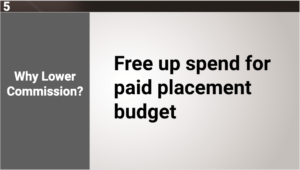
#5 Free Up Spend for Paid Placement Budget
This was a fun question for those who were in attendance for my presentation, “How many of you have clients, or a boss who says, ‘I want to grow revenue through the affiliate channel in 2020, but we have no budget to invest in media spend.’ Good times right?”
One of the strategies we employ at JEBCommerce is to lower commission payout to free up budget for paid placements.
- If you are reading this as a publisher, you may be a bit bummed out right now. Hear me out. Our goal with this strategy is to free up spend to then turn around and test placements with high value publishers.
- We lowered commissions for one of our coupon publishers driving “bottom funnel conversions” from 3% to 1%.
- Then we quantified the savings and invested that difference into media spend.
- In this example, the publisher earned $5,400 in commission in 2019 at 3%
- Total savings if we lowered this publisher to 1% in 2020 would be $3,600 of spend that would have paid out on sales the client didn’t want to pay out on because they didn’t find much value in those sales that could now be invested in top of funnel placements as part of a 2020 plan.
A couple of things to keep in mind in this example:
- If your client trusts you and your gut, and they should, they should trust you to manage these negotiations.
- Work with your trusted partners to identify opportunities to test paid placements and do yourself a favor and either:
- Clearly communicate with your advertiser that you are testing without any prior history or expectation of performance.
- Most likely, that won’t fly, so work with the publisher to forecast performance of similar advertisers to get an idea of traffic and anticipated revenue, chances are your advertiser will be more willing to test a placement with an estimated ROI.
Case study
Our beauty and skincare client needed an advanced affiliate strategy that sparked sales growth and increased the efficiency of their spend. After a comprehensive audit of the client’s program as well as a review of each partners’ marketing efforts on behalf of the client, the JEB team provided a comprehensive plan.
The team found that the affiliate partners fell into two main groups, the affiliates that were working intentionally to find, attract and close new and existing customers for the client and those that were doing very little work. The team also saw that the highest return on spend came from focused promotions and placements with a select group of affiliates.
In order to leverage these findings, we reduced the publicly available base rate commission from 10% to 5%. This reduced cost of sales that were coming through with less direct and concentrated effort on the affiliate’s behalf. That reduced the overall budget needed to support those sales, allowing us to spend more on our more active and effective partners. We used that budget to laser focus on the placements and activities that had the history of performance and/or were most likely to produce increased revenue at an effective rate.
Efforts in year 1 produced a 46% increase in ROI through the channel and a 31% overall cost reduction. As an added bonus they also realized a 5% lift in revenue.

Data Should Drive All of Your Decisions
Data should be driving these decisions, not gut feelings. If you are optimizing for new-to-file, dive into each affiliate’s performance and pay accordingly. Rather than set up a generic structure that applies to all affiliates, simply adjust the payout for each affiliate AND communicate effectively to them, to make sure they understand exactly what your plans are.
Data = dollars / either dollars wasted OR dollars saved
Whether you are paying more for NEW customers/high margin products or incrementality, data should DRIVE all of your decisions.
Where does your data come from? If your day-to-day advertising contact doesn’t have access to the data you need, you should ask if you can speak with their analytics or B&I team. Remember, you don’t want to make these decisions in the dark.
Takeaways
- Test tiered commission to incentivize your publishers
- Set commissions based on incrementality
- Increase payout on high margin items
- Increase payouts on new vs returning customers
- Increased paid placement budget
One of the questions from my session was from a new affiliate manager who asked if all 5 of these tactics should be implemented at the same time. As I told him, the short answer is no. Test these over time to see which ones resonate are aligned with your client’s goals and go from there.
I hope you have found some practical and applicable tactics for driving revenue by leveraging publisher payouts. Please feel free to add any comments or questions below.



